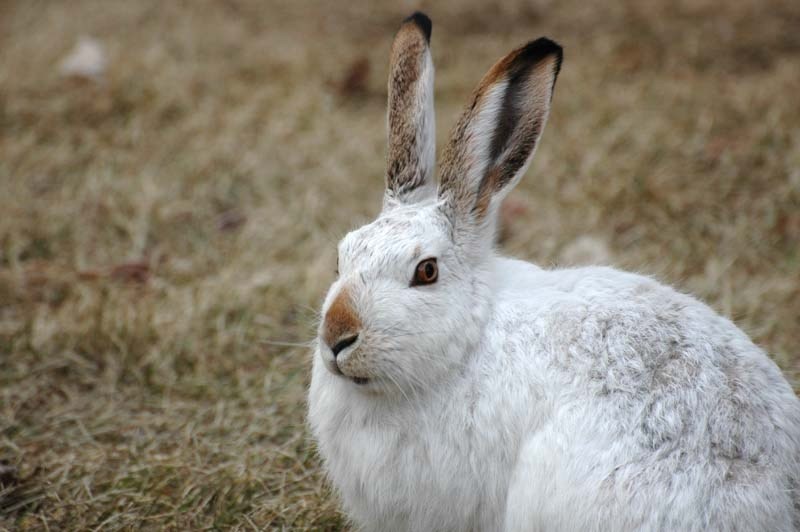Bunnies are everywhere in St. Albert: in the forests, hiding under bushes; in the streets, bounding boldly along the boulevards; in your shrubbery, chewing your carrots.
Bunnies are everywhere in St. Albert: in the forests, hiding under bushes; in the streets, bounding boldly along the boulevards; in your shrubbery, chewing your carrots. Even now, in the deep of winter, they're still active, floating above the snow as we struggle to shovel our cars out of yet another snowdrift.
You can practically trip over the ones at the University of Alberta, which are so tame that they'll let you walk within a metre before they shuffle off. The ones around town here are typically shyer, slowly elevating their ears in alarm as you approach and then suddenly zipping off in a burst of speed.
City arborist Kevin Veenstra says there are about three of them that hang around the public works yard – he thinks they camp out under the vehicles. "You definitely see their footprints more than their activity."
But every time I spot one of these fellows, I always have the same question: is it a white-tailed jackrabbit or a snowshoe hare?
Retired U of A renewable resources professor Jim Butler gets both in his yard in Edmonton, and sometimes feeds them lettuce.
Most of the bunnies you see in town will be white-tails, he says. "They're everywhere in the city," he says, and far more urbanized than the snowshoes. Animals of the open grasslands (as suggested by their long, black-tipped ears, which help shed heat in hot south), these creatures are built for running on hard surfaces, and will invariably stick to the street to sprint when surprised. They're also much bigger than snowshoe hares.
You're much less likely to see a snowshoe hare in the open, he continues. These bunnies are more secretive, and prefer to stick to well-maintained paths in the forest with plenty of cover. They'll have shorter, all-white or all-brown ears to retain heat in the cold north, and huge, wide, hairy back feet that support them like snowshoes. Unlike the white-tails, snowshoes will bolt for deep snow and shrubs when surprised, letting their pursuers flounder in the white stuff as they zip across the surface.
I'll focus on the white-tails for this piece.
White-tailed jackrabbits should really be called "jack-hares," notes Lu Carbyn, co-owner of the Wildbird General Store, because they're hares. Rabbits bear young without hair, he explains, whereas hares are born fully furred and ready to hop within hours.
White-tails arrived in Edmonton around 50 years ago and only really took off in number in the last 20, Carbyn says. "They've really been able to adapt to city life in quite a short period of time."
Normally creatures of the southern plains, Butler says the white-tails have flourished here because we've made huge flat areas full of food for them called cities. Coyotes have also figured this out, he notes, and often enter cities to hunt hares.
Both white-tails and snowshoes turn their coats from brown to white during the winter for camouflage, Carbyn says. (The white-tail will keep the black tips on its ears, though.)
When at rest, as they typically are during the day, the white-tails will sit in a depression with their ears down and their eyes just peeking over the edge, making them tough to spot. (This isn't always the case, of course – I've seen them brazenly sitting on open street corners and front lawns.)
White-tails will typically wait until their enemies are very close before they leap into action, Carbyn says, using their powerful hind legs and traction-giving claws to blast off at up to 55 kilometres an hour. "They just explode and take off at very high speed," he says, often startling their predators.
Most active around dawn and dusk, white-tails prefer to eat bark, dry grass and shrubs in the winter, which Veenstra says has caused the city's shrub-replacement crews some grief in the past. You can use smelly moth-balls or cinnamon to deter hares from eating your plants, he notes.
Most white-tails will stick to set paths and territories, Veenstra notes, and will often show up in predictable places. Many residents become attached to them. "It's natural, and I think it's pretty cool."
White-tailed jackrabbit
Name:<br />Lepus townsendii, a.k.a. prairie hare, white jack.<br /><br />Appearance:<br />Brown or white hare with long, black-tipped ears, long, thin back feet, and a white tail.<br /><br />Commonly seen:<br />Hopping along the street, squatting on your front lawn, eyeing you suspiciously.<br /> <br />Occasionally confused with:<br />The snowshoe hare, which is smaller, has shorter ears with no black tip, prefers forests, and has huge back feet that let it run on the surface of snow.<br /><br />Fun fact:<br />Like deer, they will often leave their babies (leverets) alone for long periods during the day, returning only to feed them. Residents should not try to rescue these “abandoned” babies.
Wild St. Albert
Like wildlife? So do we! Every second Wednesday the Gazette profiles a reasonably common wild creature in the St. Albert region. Birds, beasts, bugs, fish … so long as it's alive and kicking, we'll feature it. <br /><br />Got a creature you'd like to see profiled? Send your suggestions to [email protected].




